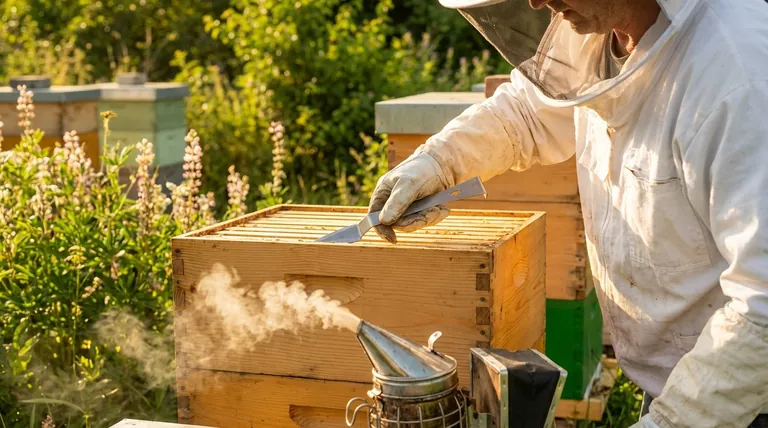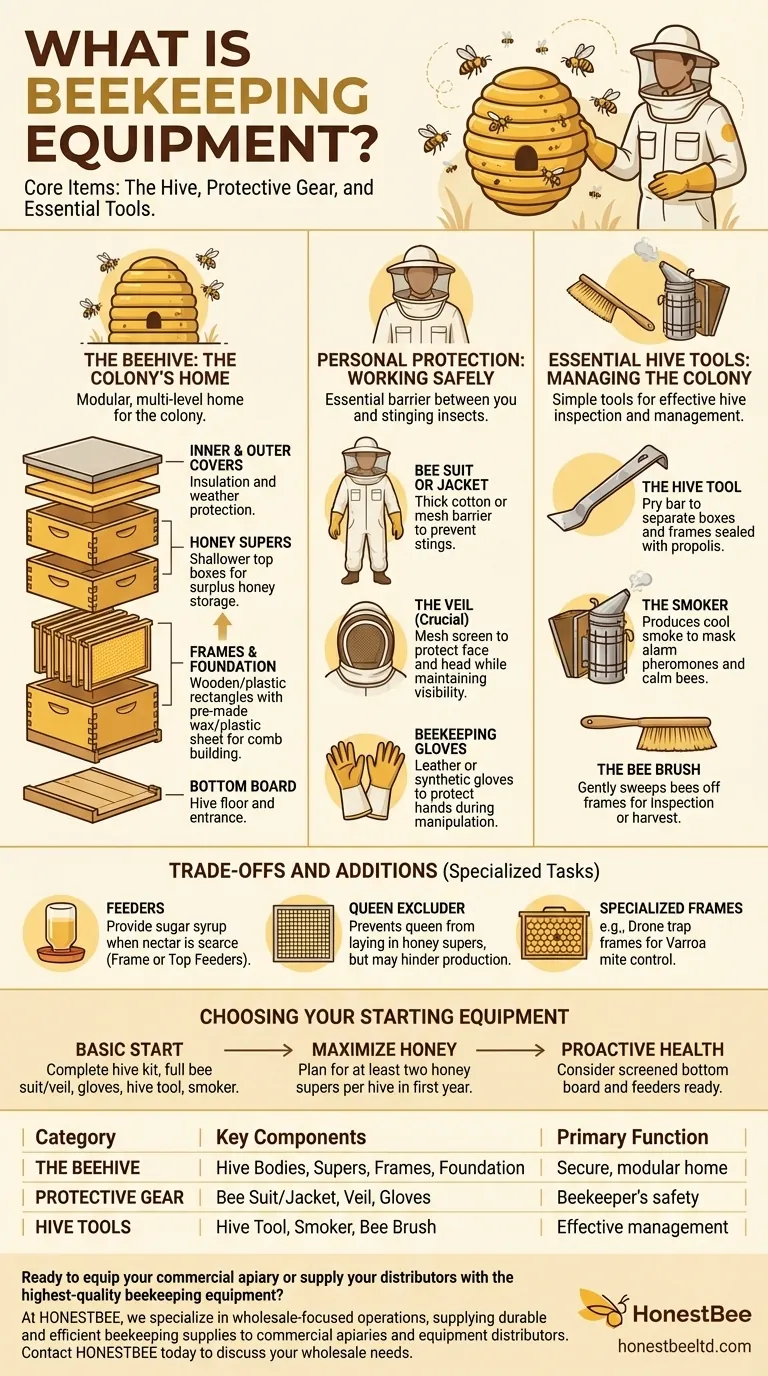At its core, beekeeping equipment is the set of specialized tools and structures that allow you to safely house and manage a honey bee colony. The essential items fall into three main categories: the hive itself, personal protective gear for the beekeeper, and the tools used to inspect and work with the bees. This foundational kit enables everything from basic colony care to the eventual harvest of honey.
Understanding beekeeping equipment isn't about memorizing a shopping list. It's about recognizing how each component serves one of three critical functions: providing a secure home for the bees, ensuring the safety of the beekeeper, and enabling effective hive management.

The Beehive: The Colony's Home
The beehive is the most fundamental piece of equipment. It is a modular, multi-level structure designed to mimic the natural cavities where bees build their nests, while also allowing for easy inspection and honey collection.
Hive Bodies and Supers
A modern beehive is essentially a stack of boxes. Hive bodies, also called brood boxes, are the deep boxes at the bottom where the queen lays eggs and the colony raises its young bees (brood).
Honey supers are the shallower boxes stacked on top of the hive bodies. These are intended exclusively for the bees to store surplus honey, which is what the beekeeper harvests.
Frames and Foundation
Inside each box hang several frames. These wooden or plastic rectangles provide the structure upon which the bees build their beeswax comb.
Most frames are fitted with a sheet of foundation, a pre-made wax or plastic sheet with a honeycomb pattern embossed on it. This encourages the bees to build straight, manageable combs.
Essential Structural Components
Several other pieces complete the hive structure. The bottom board serves as the floor of the hive and provides an entrance for the bees.
An inner cover sits on top of the uppermost box, providing insulation and a bee-free space. The outer cover, or telescoping lid, acts as the hive's roof, protecting the colony from the elements.
Personal Protection: Working with Bees Safely
Working safely and confidently with tens of thousands of stinging insects requires proper protective gear. This equipment is non-negotiable, especially for beginners.
The Bee Suit or Jacket
A full bee suit or a jacket provides a complete barrier between you and the bees. Modern suits are often made from thick cotton or multi-layer mesh, which prevents bee stingers from reaching your skin.
The Veil
The veil is the single most important piece of protective gear. It is a mesh screen that covers your head and face, protecting the most sensitive areas from stings while maintaining visibility and ventilation.
Beekeeping Gloves
Gloves protect your hands from stings, which is crucial when you are manipulating heavy frames covered in bees. They are typically made from leather or durable synthetic materials.
Essential Hive Tools: Managing the Colony
Beyond the hive and protective gear, a few hand tools are required for every hive inspection. These simple but effective tools make hive management possible.
The Hive Tool
This is the beekeeper's pry bar. It is a piece of flattened steel used to gently separate the hive boxes and frames, which bees often seal together with a sticky resin called propolis.
The Smoker
A smoker is a small metal can with a bellows that burns fuel (like pine needles or burlap) to produce cool, white smoke. Puffs of smoke at the hive entrance and over the frames help calm the bees by masking their alarm pheromones, making inspections much smoother.
The Bee Brush
This is a soft-bristled brush used to gently sweep bees off a frame. It is essential when you need to inspect a frame for eggs or clear bees away before harvesting honey.
Understanding the Trade-offs and Additions
Once you have the basics, you'll encounter additional equipment designed for more specific tasks. These often involve trade-offs between convenience, cost, and beekeeping philosophy.
The Role of Feeders
Feeders are used to provide bees with sugar syrup when natural nectar sources are scarce. Frame feeders take the place of one or two frames inside the hive, while top feeders sit on top of the hive boxes under the lid, offering a less disruptive way to feed the colony.
The Queen Excluder
A queen excluder is a flat grid with openings large enough for worker bees to pass through but too small for the larger queen. Placed between the brood box and honey supers, it prevents the queen from laying eggs in the honey-harvesting area, but some beekeepers believe it can hinder honey production.
Specialized Frames
While most frames are for brood or honey, some serve unique purposes. Drone trap frames are designed to encourage the creation of drone brood, which can then be removed as a method of controlling Varroa mite populations.
How to Choose Your Starting Equipment
Your initial equipment choices should align with your primary goal for keeping bees.
- If your primary focus is starting with the absolute basics: Invest in a complete hive kit, a full bee suit with an integrated veil, gloves, a hive tool, and a smoker.
- If your primary focus is maximizing a potential honey harvest: Plan to purchase at least two honey supers (medium or shallow boxes) per hive in your first year.
- If your primary focus is colony health and proactive management: Consider starting with a screened bottom board for mite monitoring and have feeders ready before you install your bees.
Selecting the right equipment is the first step in building a successful and rewarding partnership with your bees.
Summary Table:
| Category | Key Components | Primary Function |
|---|---|---|
| The Beehive | Hive Bodies, Supers, Frames, Foundation | Provides a secure, modular home for the colony |
| Protective Gear | Bee Suit/Jacket, Veil, Gloves | Ensures the beekeeper's safety during inspections |
| Hive Tools | Hive Tool, Smoker, Bee Brush | Enables effective and safe hive management |
Ready to equip your commercial apiary or supply your distributors with the highest-quality beekeeping equipment?
At HONESTBEE, we specialize in wholesale-focused operations, supplying durable and efficient beekeeping supplies to commercial apiaries and equipment distributors. Our products are designed to support large-scale operations, maximize honey production, and ensure colony health.
Contact HONESTBEE today to discuss your wholesale needs and build a more productive partnership with your bees.
Visual Guide

Related Products
- HONESTBEE Professional Long Handled Hive Tool with Precision Cutting Blade
- HONESTBEE Advanced Ergonomic Stainless Steel Hive Tool for Beekeeping
- Professional Multi-Function Stainless Steel Hive Tool
- Professional Dual-End Stainless Steel Hive Tool for Beekeeping
- Wholesales Dadant Size Wooden Bee Hives for Beekeeping
People Also Ask
- What are the basic tools for beekeeping? Essential Starter Kit for Safe & Successful Hive Management
- How should beekeepers handle bees when using a hive tool? Master Calm, Deliberate Techniques
- What are the features of a regular hive tool? The Essential Multi-Tool for Every Beekeeper
- What is a hive tool used for in beekeeping? Your Essential Guide to Hive Management
- What are some common uses of a hive tool? Essential Multi-Purpose Tool for Every Beekeeper



















